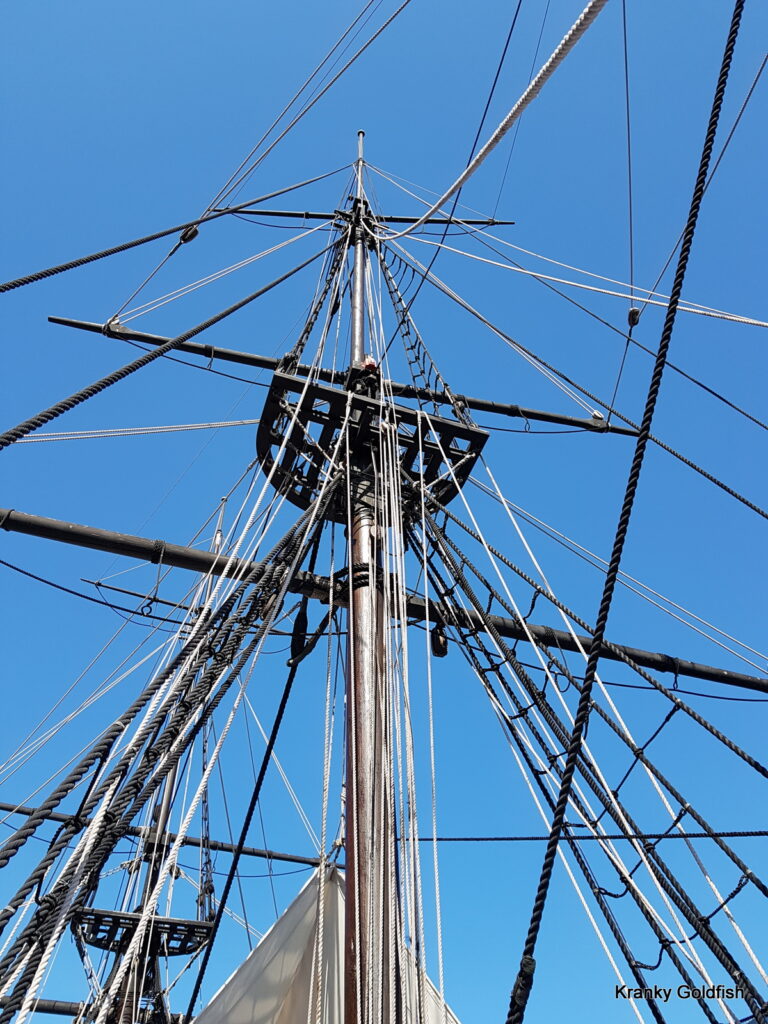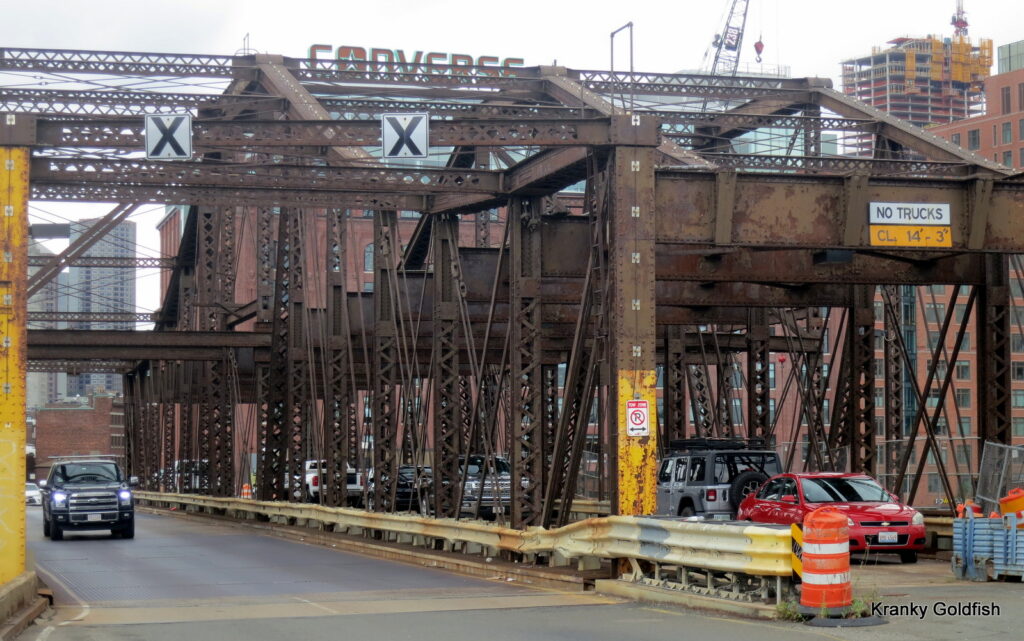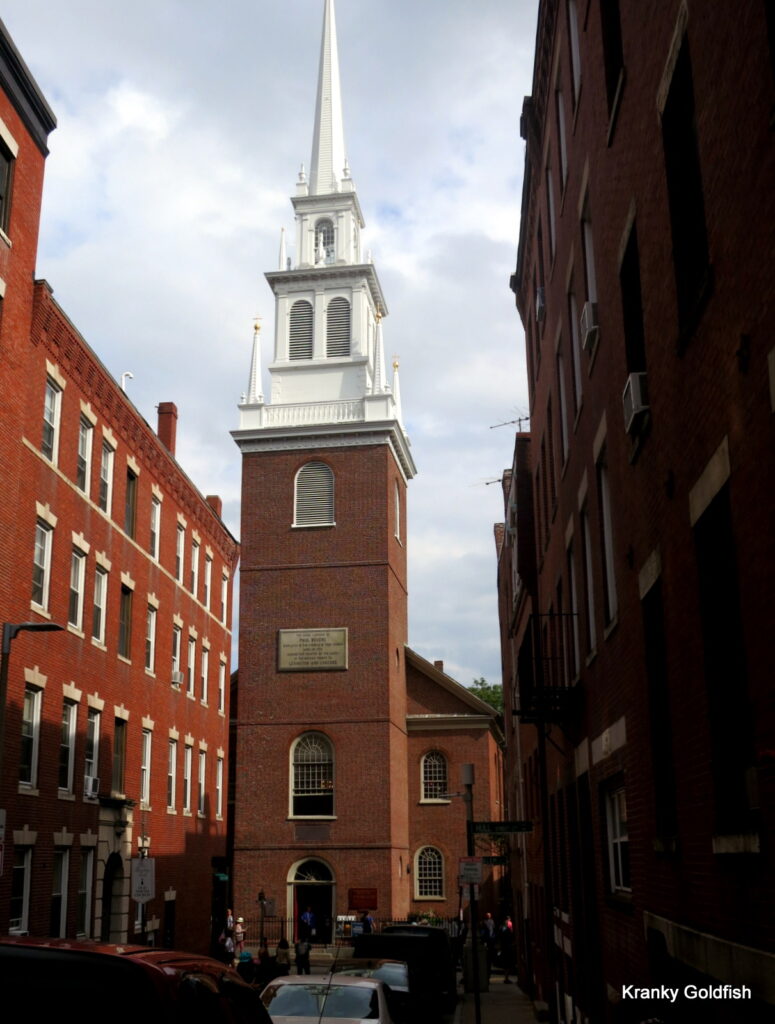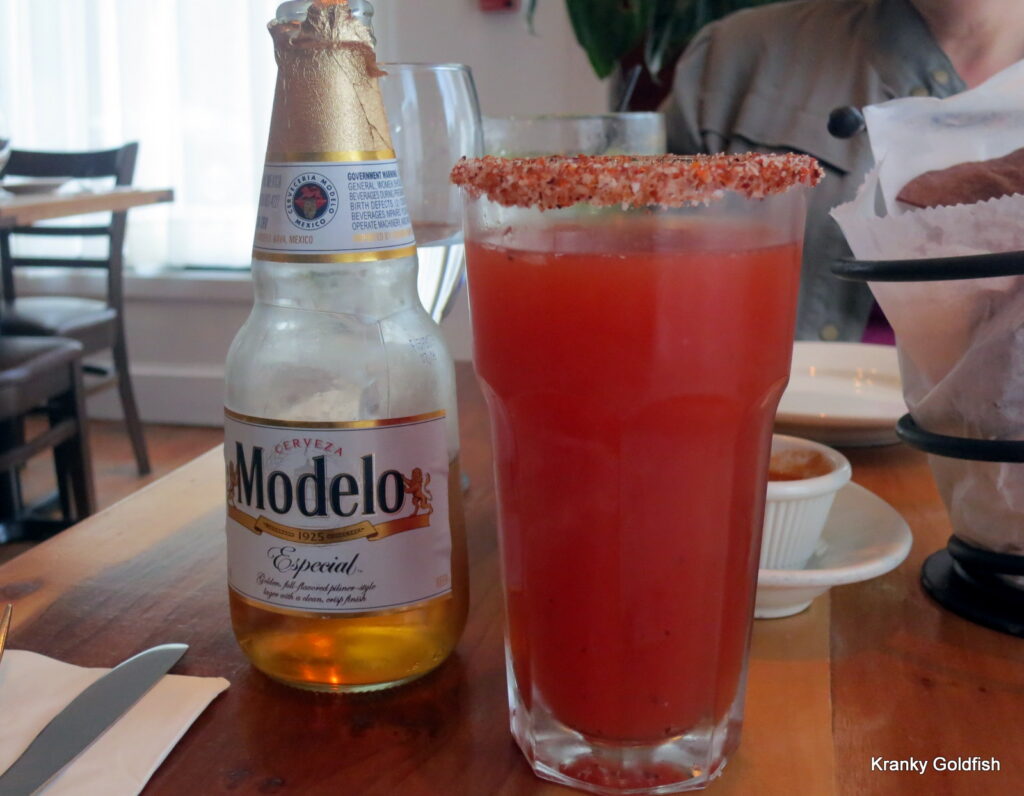-
Day 6 (ctd.) Boston. Cetacean, Customs, Chowdah.
T is for Townshend
After our whale-watching we hied ourselves down to the Boston Tea Party Ships & Museum.
Everyone has heard of the Boston Tea Party, haven’t they? A group of brave patriots cunningly disguised themselves as Mohawk warriors and threw evil British tea into Boston Harbour as a protest against the evil British raising taxes on tea. And did I mention how evil the British were?
As usual in real life, the truth was a bit more nuanced than that.
There were a few of the tea-dumpers dressed as Mohawks, although according to some sources the disguises consisted of literally a few feathers in their hair and taking their shirts off (did I mention it was December 16th and jolly cold?) which honestly sounds about as convincing as me sticking a couple of pencils under my upper lip and claiming to be a walrus.
The 1773 Tea Act taxes were actually a reduction on the tax rate for tea imposed by the Townshend Act taxes in 1767. But the colonists had pretty much been ignoring those taxes and drinking smuggled tea for the last few years, so I guess the lower tax rate was actually higher than paying no tax. Interestingly, the price of tea plus tax was lower than the smuggled price, so it wasn’t just about the price. The issue of taxation without representation was definitely in the front of many colonist’s minds.
But enough history! What about the museum?

The Museum is in the middle of Fort Point Channel, a pleasant walk south from Long Wharf where the Aquarium and harbour cruises are. Access is from the Congress Street bridge.
The tour starts in a mini-version of the Old South Meeting House, where the visitors join in a mini-version of the meeting that led to the Tea Party. Boo taxes! Yay liberty!

Visitors are given little cards with some biographical details of people who were present at the meeting, some of whom took part in the tea-dunking, and encouraged to take part in the Yays! and Boos!

Then it’s down to the dock to see the replicas of two of the ships involved in the Tea Party, and some exhibits of items and replicas of dockside times in 1773 Boston.

Then upstairs again for some more exhibits including a short film about the Minutemen and a well-stocked gift shop.
Overall the museum is interesting and entertaining, and a pretty worthwhile way of spending a couple of hours at USD30 for adults and USD22 for urchins.
Boston Meanz Beanz
Our fourth day in Boston and we haven’t had beans or chowder yet, shame on us. Dinner on day 6 was dedicated to experiencing traditional Boston food.
A little bit north of Faneuil Hall is Union Street, populated by a row of pubs and taverns. Among them is the Union Oyster House, an icon of Boston pubs which has been running as a restaurant for nearly 200 years in a Colonial-era building that is at least a hundred years older again.

Please forgive the photos below. As you can see the lighting inside is entirely housed in extremely yellow fittings. I’ve de-yellowed the pictures as much as I can but they are still pretty average.

Inside and upstairs, the dining room is low ceilings, heavy beams, and a mixture of tables and booths. The menu is heavy on seafood, with plenty of oysters, lobster, clams, chowder, shrimp dishes and a steak and chicken dish just in case you don’t like seafood (although vegetarians get short shrift with just a couple of salads and a vegetable side dish to choose from).
We wanted to experience traditional Boston food so we ordered a range of classics.

Crab cakes are always a favourite. These were pleasantly meaty.

Boston Tea Party cocktails – iced tea with citrus vodka – went down very smoothly after a long day of whale watching and general touristing.

Seafood platter with oysters Rockefeller, grilled clams, oysters and shrimp.

The famous clam chowder was creamy and hearty with plenty of clams.

Cornbread, another New England staple, was soft and fluffy, slightly sweet in the local style which to be honest is not to my personal tastes. What can I say, I like my cakes sweet and my bread not.

Boston baked beans, at last! Again in a traditional New England style, these are hearty in a rather wet, soupy base and very lightly flavoured. A good side dish or breakfast.
And that’s kind of the thing about New England cooking. It was born of a time and place when a quarter of a pound of salted pork belly was what you had to give a little meaty kick to a chowder which was mostly potatoes and milk and clams. It was simple, and hearty, and kept body and soul together in a long winter when there wasn’t much in the way of greens and there definitely weren’t fancy spices and artisanal vinegars piled up on the shelves of your local supermarket. Let’s appreciate it for what it is.
Union Oyster House is an old-school food destination serving hearty time-honoured dishes in a traditional style. Not the cheapest, with our visit running USD 125 with tip, but we had a good taste of classic Boston food and few nice drinks before heading home to rest up for another long walk on the Freedom trail.
-
Day 7. Boston. Constitution, Charlestown, Cannoli
In which we visit Chahlestown, finish the Freedom Trail, and have some excellent Mexican food for dinner.
Getting around Boston
Getting around Boston as a tourist is pretty easy, as it is in most big cities these days. Just buy a Charlie Card from a bus or T stop, and they are available from some convenience stores and news stores. If you are in town for more than four days or so, a seven-day pass is $22.50 and gives you unlimited access to the subway, buses, Silver Line rapid transit buses, some ferry lines, and the heavy rail commuter trains in zone 1. Which as a tourist is all you are likely to need.
We did most of our travel on the subway – actually mostly we walked, but when we did take transit it was mostly subway as we were right near several subway stops, with the occasional bus for variety, subway coverage being a bit thin north of the Charles River.
Boston Navy Yard
So on Day 7 in Boston we planned to finish the Freedom Trail, covering the parts in Charlestown and Boston Navy Yard, then walking back across the river to finish in the North End. And indeed, it was a bit of a long walk to the Navy Yard – which is north of the Charles – so we cheated and took the bus. But being on the way home is a great motivation for completing a healthy walk.
If anyone doesn’t already know, I am a huge navy nerd. It is practically impossible for me to go past a museum, or, even better, a museum ship, without stopping to have a look around. So the Navy Yard was always going to be a visit for us. And Doreen, bless her, is almost endlessly patient with me and does a good imitation of looking interested at my constant shipsplaining.
For over 170 years Boston Navy Yard built ships for the US Navy. Nowadays to the average tourist it is better known as the home of the USS Constitution, the oldest active service vessel in the Navy.

The old stores admin building is now a museum dedicated to the days of sail and the building of, and life aboard, the original six frigates of the Navy. Most of the exhibits are aimed at the kiddies, but it’s interesting enough for a quick walk-through for adults. The building also has restrooms and a cafe.

Dry dock Number 2 once built and repaired ships by the dozen. Now … well, it has seen better days.

As indeed has much of the heavy machinery left as a memorial to the days of industry.

USS Constitution was laid down in 1794 in Boston, not at the Navy Yards which weren’t founded until about 1800, but just across the river in North Boston where the Coast Guard base is now.
She had a storied history, fighting Barbary corsairs and winning separate frigate-to-frigate battles against HMS Guerriere and HMS Java during the war of 1812. If you are after a good source with more detail, I recently read “Six Frigates” by Ian Toll, a history of the early US Navy and heartily recommend it.
Nowadays she is preserved, mainly as a museum ship but technically an active service vessel, as every July 4th she sails out into the estuary to fire a salute as part of Boston’s celebrations.

Cannon on the upper deck of USS Constitution.

The main deck is clean, light and airy now. It would have been a different matter battened down in a North Atlantic storm with a couple of hundred unwashed sailors swaying and snoring in their hammocks after a hearty meal of salt beef, hard tack and dried peas.

Beside the Constitution was possibly the cutest little utility tender in the Navy.

Also at the Navy Yard is the USS Cassin Young, a Fletcher-class destroyer from WWII also preserved as a museum ship. She served in the Pacific in WWII and in the Atlantic and Mediterranean until 1960. Only mildly modernised, she is in great condition and is well worth spending an hour going over.

Depth charge racks on USS Cassin Young.

USS Cassin Young from the dock. With those sleek lines you can see why destroyers were called the greyhounds of the sea.
Back on the Trail
From the Navy Yard we made our way back to the Freedom Trail as it led up to Bunker Hill. It’s a pleasant walk through the almost village-like suburb of Bunker Hill up to the park and memorial on the hill itself.

Looking down Soley Street towards Boston from the lower end of Bunker Hill park. Just over a mile from downtown Boston, Bunker Hill is on the other side of the river on a small peninsula and is a quiet, less built-up urban oasis.

Looking down Monument Avenue from the park. The statue is of Colonel William Prescott, who commanded the American militia forces at the battle. He is the source of the famous order “Do not fire until you see the whites of their eyes”, given because of the militia’s shortage of ammunition during the battle.

The memorial obelisk and the front of the Lodge, which holds exhibits about the battle and some interesting portraits and maps.
The Battle of Bunker Hill, as is so often the case with these things, did not take place on Bunker Hill where the park and memorial are. Rather it was on Breed’s Hill, a few hundred yards to the south-east. Why the different name? I have no idea.

Another view of the obelisk.
The Battle of Bunker Hill was fought on June 17, 1775 when British forces attempted to close on Boston from the north and the south and crush the barely-begun rebellion. American militia forces hurriedly fortified Breed’s Hill on the Charlestown peninsula to resist the attack from the north. After a day of vicious combat with three frontal attacks by the British, the American forces retreated in good order due to lack of ammunition, leaving the British with the field and heavy casualties. The battle showed that American militia forces were able to match British regulars in pitched combat, and the British losses instilled a sense of caution which may have slowed them crucially in the coming campaigns.

The Freedom Trail path ends at the top of Bunker Hill. It’s a long walk for a little cow with short legs.

Walking back to downtown Boston from Bunker Hill you can cross the North Washington St bridge. In a city of gleaming skyscrapers, elegant art deco and simple classic colonial architecture, I find a pleasant contrast in the grit and texture of a rough, functional, piece of industrial engineering. They’ll probably rip it down soon and replace it with something that an architect gets an award for.
One if by land, two if by sea
So far we had been through the parts of the Freedom trail near the Common and Downtown, and of course the morning had seen us in Charlestown. The remainder of the trail is in the inner north-east part of town known as North End.

Old North Church (properly speaking Christ Church in Boston), built in 1723, is the oldest church standing in Boston today. It is famous as the place where Thomas Newman, then the sexton of the church, shone two lanterns on the night of April 18, 1775, signifying that British troops were moving by sea on their way to intercept American militia at what would be the battle of Lexington and Concord. The warning conveyed by Paul Revere and William Dawes allowed the militia to be alert for the first battle of the war.
The church itself is a handsome brick building based on a picture of a London church designed by Sir Christopher Wren. I must confess we did not go inside, probably due to a combination of it having been a long day’s walk with more to go and an admission fee of $8 per person.

The spire of Old North Church seen from Copp’s Hill Burial Ground.
In use since 1660, Copp’s Hill was at one time almost at the shoreline of Boston Harbour but thanks to a couple of centuries of landfill it is now set well back.
The neat paths, lawns and rows of headstones are a relatively recent practice. Originally graves were placed pretty much anywhere that was free, with plots being re-used as necessary and headstones moved around similarly. In the early 19th century a trend arose for city parks with paths and lawns as a place for residents to promenade in a healthy and respectable manner. In cities like Boston, though, land was limited by being surrounded by the harbour and river, and every scrap was already in use with the only open space being burial grounds (which had already been filled several times over). What to do? Could we … line up the headstones neatly and put in some lawns and paths? And if there are too many headstones, could we just … overlap them, to save space?

Yes. Yes we could. So, if you’re in a burial ground in Boston in sections with burials earlier than about 1830, don’t be worried about standing on a grave. You probably already are, and you can’t avoid it because they are everywhere.

On a slightly less morbid note, the North End is also home to Boston’s famous Spite House. Local history holds that the land was owned by two brothers, one of whom built a large house on most of the land while the other was serving in the military. On his return the other brother built the spite house on what was left to deprive his sibling of a carriageway, because … well, because he could, I guess.

Further on in the North End is the Paul Revere House. Leaving aside the somewhat mythologised story of his midnight ride, Revere was a remarkable man. A spy for the Sons of Liberty, he was famously a silversmith and also a serial entrepeneur, who
- crafted false teeth then branched out to become a dentist, installing them
- set up a gunpowder mill that helped to supply the American militia in the early days of the Revolutionary War
- served in the war as a lieutenant-colonel of militia, commanding engineering and artillery troops
- innovated using technologically advanced rolling-mill production of sheet metal (remember the Capital dome from before?) and mass-production methods
It’s almost a shame that we didn’t get Revere! the musical instead of Hamilton!, but Revere lived a long successful life, had sixteen children, and died of old age at 83. Which I guess is not as exciting a story, somehow.
Revere owned the house on North Square from 1770 to 1800 and lived in it with his family probably in the 1770s. The house was rebuilt and used over the years as many things including shops and tenements, then bought in 1902 to be restored as a museum and memorial. It is a mix of reproduction and original, and a very interesting window on the life and times of Revere and his family in those days. Well worth a visit and an hour or so of your time.

Just around the corner is the Paul Revere Mall. Sadly there is no Macy’s.
The North End is the area of Boston nearest the port and as such has historically been the home to new migrants as they arrive. Irish in the mid-19th century, Italians in the late-19th century and since, and sailors, bars and ladies of the night all the time.
Nowadays it’s definitely an Italian district, with some beautiful ornate building facades and many a cafe and trattoria.

And while in Boston’s Little Italy, it’s hard not to stop and enjoy a pastry. But what should we get, and from where?

When it is literally what you get when you Google, it’s hard to go past Mike’s.


We had an amaretto-flavoured cannoli; I can faithfully say that the shell was crisp, the filling was smooth and sweet and tasty, and it was pleasantly messy to eat. Tourist tip – keep some wet wipes in your day pack for when cannoli strike!
Mexican in Boston?
Sure, why not? Like pretty much any big American city, Boston has had plenty of immigration from Latin America. It’s pretty impossible to get authentic Mexican food in Melbourne, especially at a decent price, so we set out to take advantage of the opportunity.
Angela’s Cafe is located across the river in East Boston. From downtown it is a short T trip to the Airport station and then a ten or twelve minute walk through quiet, mostly residential streets. It’s been a local fixture since 2007; although sadly Angela herself passed away in July 2020 the cafe is still there as of writing this.

From the outside the cafe is a plain building with tiny signage; but inside it is bright and lively with cheery staff and happy local customers (and, tonight, a couple of foreign tourists).

Tortilla chips with green and red salsa are a treat, but also a trap for young players. We wanted to taste as many dishes as possible so we snacked sparingly on them while sipping our lime margaritas.

Embracing the theme, I next tried a michelada. Which is kind of a Bloody Mary with beer instead of vodka, I guess? Beer, tomato juice, Worcestershire sauce, hot sauce, in a salt-and-spice rimmed glass. It was hearty and refreshing and probably full of vitamin C, and I can see on a hot day in the sun they would go down very smoothly. But I didn’t feel the need for another one just then.

Wanting to taste as wide a range as possible, we split the tasting plate of chicken mole gordita (pastry stuffed with chicken in a chili and chocolate sauce), tinga tostada (shredded chicken in a chipotle-tomato sauce), taco árabe (pork shawarma taco, created by middle eastern immigrants to Mexico), ceviche tostada (fresh fish marinated in lime juice with chili and salsa) and taco al pastor (another middle eastern import, marinated pork grilled with pineapple of all things). All were fresh and delicious.
These next two dishes were what I really came to try. Mexican feast food is a world away from the Tex-Mex and street food dishes that most of us are familiar with. Complex sauces can be made up of a half dozen different types of chili, each carefully included for a specific aspect of heat or smoke or fruitiness, rich stock bases, a dozen different spices, carefully ground nuts, and often tomatoes or tomatillos. Choice cuts of meat are simmered in the sauces which are often finished with fresh pureed herbs. I’ve made some of them at home but never eaten an authentic version.

Pork loin in a mole sauce. Mole rojo is a chili and tomato based sauce thickened with masa or almond meal and finished with just a touch of bitter chocolate. It is rich, smooth, complex, smoky from chipotle peppers and well tasty. Angela’s version has hints of sweetness from raisins and banana.

Chicken breast in pipian verde. The sauce is made from green tomatillos, chicken broth, pureed spinach and parsley (I use coriander when making it at home) and enriched with ground sesame seeds which bring a nuttiness to the tangy herbiness.
As usual the serves were generous to the point that we got almost half the meal boxed to take home and have for lunch later – another reminder of how good it is to have an apartment with a fridge and kitchen instead of a crampy hotel room when staying in one place for more than a few days.
So that’s much more than you ever probably wanted to know about Mexican feast food, even though we just scratched the surface. The good news is that my home-made Australian versions tasted almost exactly like the real thing, and that if you are in Boston you can go to Angela’s and try it for yourself.